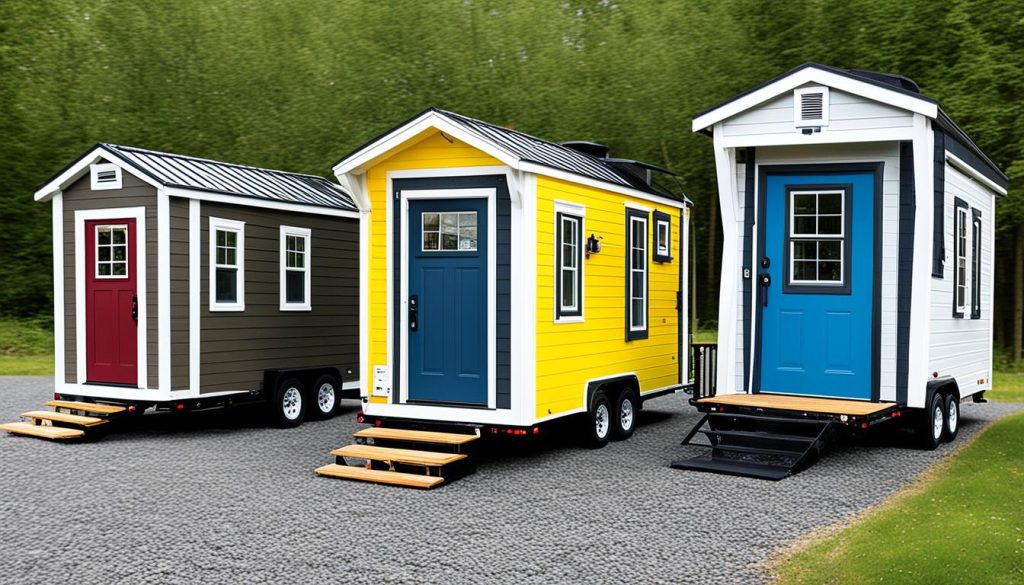Did you know that the weight of a tiny home is directly tied to its size? In fact, on average, a tiny house weighs about 500 pounds for every foot of length. That means that even a small tiny house can weigh thousands of pounds!
When it comes to planning and building your tiny home, understanding its weight is crucial. From towing capacity to weight distribution, there are several important factors to consider. Let’s delve deeper into the world of tiny home weights and discover how to ensure a safe and secure journey for your portable abode.
Key Takeaways:
- The weight of a tiny house is typically around 500 pounds for every foot of length.
- Legal weight limits for towing a tiny house on wheels range from 16,000 to 20,000 pounds.
- Consider the towing capacity of your vehicle to ensure safe transportation.
- Proper weight distribution and balance are essential for a stable and secure journey.
- Regular maintenance and monitoring can help ensure the continued safety of your tiny home.
Maximum Size and Permits for Tiny Houses on Wheels
When it comes to building a tiny house on wheels, there are certain size limits to consider in order to comply with regulations and obtain permits for transportation. While the Federal Size Regulations for Commercial Motor Vehicles do not specify a height requirement for tiny houses on wheels, most states have height limits ranging from 13’6″ to 14′. Exceeding these height limits would require permits for transportation.
The maximum width limit for the exterior of the tiny house is generally 8’6″. This ensures that the tiny house is within the standard size limits for safe transportation on roads and highways. Length limits vary by state, but exceeding 40′ could cause transportation issues.
It’s important to note that the size of the trailer itself should also be taken into account when considering the overall size of the tiny house. Proper weight distribution is crucial for safe and legal transportation. Ensuring that the weight is evenly distributed across the trailer helps to maintain stability and prevent any potential damage during transport.
Practical Size Limits and Safety Considerations
When it comes to tiny houses on wheels, size limits are not just about legal restrictions, but also practical considerations for a safe and hassle-free journey. It’s important to be aware of potential hazards, such as bridges and tunnels with height restrictions that can be challenging to navigate for vehicles taller than 13’6″. To ensure added safety, many tiny house owners opt for a height of 13’4″ or below.
Another factor to consider is arch bridges, where the height drops off at the edges. Proper planning and careful consideration of these practical size limits can help you avoid potential accidents and ensure a smooth journey for your lightweight tiny home.
Take a look at this stunning collection of lightweight tiny homes. These small, eco-friendly homes are designed to blend seamlessly in natural surroundings while providing all the comforts of a traditional home.
Maximum and Minimum Weight for Tiny Houses on Wheels
When it comes to the weight of a small house, it’s important to find the right balance. A tiny home that is too heavy can put strain on your tow rig, while one that is too light may not be secure during transportation. Let’s explore the maximum and minimum weight considerations for tiny houses on wheels.
On average, a tiny house weighs around 500 pounds for every 1′ of length. This means that a 20-foot tiny home would weigh approximately 10,000 pounds. It’s important to keep in mind that this is just an average, and the weight can vary depending on the materials used and the design of the house.
When towing a tiny house, it’s crucial to consider the towing capacity of your tow rig. Make sure that the weight of your tiny house, including your possessions and the weight of the trailer itself, doesn’t exceed this capacity. Exceeding the towing capacity can strain your vehicle and lead to safety hazards on the road.
However, it’s also important to ensure that your tiny house is not too light. During transportation, tiny houses can be vulnerable to wind forces, especially on highways. By adding the appropriate weight and tie-downs, you can enhance the stability and safety of your tiny house on wheels.

Properly balancing the weight of your tiny house is crucial for a safe and secure journey. By consulting with professionals and ensuring that your tiny house is within the acceptable weight range, you can enjoy the freedom and mobility that comes with tiny house living.
Setting Up Your Tiny Home: Block and Support Systems
When it comes to setting up your tiny home, one crucial aspect to consider is creating a stable foundation using blocking and pier pads. Proper support and weight distribution are essential to ensure the safety and longevity of your tiny home.
First, let’s talk about blocking. Blocks are small, sturdy pieces of material that provide stability and support for your tiny home. These can typically be found at local hardware stores and come in various sizes and materials. When choosing blocks, it’s important to take into account the weight of your tiny home, as well as the length and width of the overall structure.
Next, we have pier pads. Pier pads are flat surfaces that rest on top of the blocks and provide additional stability. Similar to blocks, pier pads come in different sizes and materials, so it’s important to choose ones that are suitable for the weight and dimensions of your tiny home.

Now that you have your blocking and pier pads ready, it’s time to position them strategically. The weight of your tiny house should be evenly distributed on the blocks and pier pads to ensure proper support. This can be achieved by placing the blocks and pier pads at key points along the trailer frame, considering the weight distribution of the structure.
It’s also crucial to take leveling into account. Leveling your tiny home ensures that it is placed on a flat and stable surface. Unevenness can lead to structural issues, such as flexing of the frame. To level your tiny home, use shims to adjust any unevenness and achieve a stable position.
By setting up your tiny home with blocking and pier pads, you are creating a solid foundation that can withstand the weight of the structure and provide long-lasting support. Make sure to follow the manufacturer’s guidelines and consult with professionals if needed to ensure proper setup.
Anchoring and Skirting Your Tiny Home
When it comes to securing your tiny home in place, proper anchoring is essential for added stability and peace of mind. It’s highly recommended to seek professional advice and assistance for the correct installation of ground anchors, ensuring they are adequately secured to prevent any movement or shifting.
The anchor points for your tiny home are typically the steel D-rings welded onto the frame of the trailer. These anchor points serve as the connection points between your tiny home and the ground anchors. The type of ground anchor you choose will depend on the type of ground surface in your location, whether it’s soil, gravel, or concrete.
It’s crucial to select ground anchors that can safely hold the weight of your tiny home. The weight capacity of the anchors should align with the weight of your tiny home to ensure maximum stability. By choosing the appropriate anchors, you can minimize the risk of any potential movement or displacement caused by external factors such as strong winds or uneven terrain.
In addition to anchoring, skirting your tiny home offers various benefits. Skirting involves enclosing the base of your tiny home to enhance its aesthetic appeal while also serving practical purposes.
One significant advantage of skirting is its ability to keep pests out of the underbelly of your tiny home. By sealing off the gaps and openings, you can prevent rodents and other unwanted visitors from accessing the crawl space beneath your home. This helps maintain a cleaner and more comfortable living environment.
Furthermore, skirting can improve insulation by reducing heat loss and maintaining a more consistent indoor temperature. It creates a barrier against cold air entering the crawl space, allowing for better energy efficiency and lower heating costs. Consider using materials such as treated lumber, lattice, or painted strand-board for skirting, depending on your budget and personal preferences.
Comparison of Ground Anchor Types
| Ground Anchor Type | Weight Capacity | Ground Surface |
|---|---|---|
| Screw-In Anchors | Up to 2,000 lbs | Soil, Grass |
| Auger Anchors | Up to 5,000 lbs | Soil, Gravel |
| Concrete Footings | 6,000 lbs and above | Concrete, Pavement |
Choosing the right type of ground anchor and skirting materials for your tiny home ensures a secure and visually appealing setup. By protecting your investment with proper anchoring and skirting, you can enjoy peace of mind and a comfortable living space in your tiny home.
Maintenance and Monitoring
Once your tiny home is set up, it’s crucial to prioritize regular maintenance and monitoring to ensure its stability and safety. By implementing a few simple practices, you can keep your lightweight tiny home in optimal condition for years to come.
Start by checking the leveling of your tiny home after the first week of setup, followed by monthly inspections and as needed to account for ground conditions. If you notice any signs of settling or misalignment, don’t worry! Simply utilize bottle jacks and pier shims to readjust and restore stability.
Regular maintenance is key to preserving the integrity of your tiny home. It is advisable to establish a network of reliable service providers who can assist you with site maintenance and any future modifications. An experienced professional will ensure that your tiny home remains safe, secure, and compliant with the tiny house weight limit requirements.

Leave a Reply
You must be logged in to post a comment.